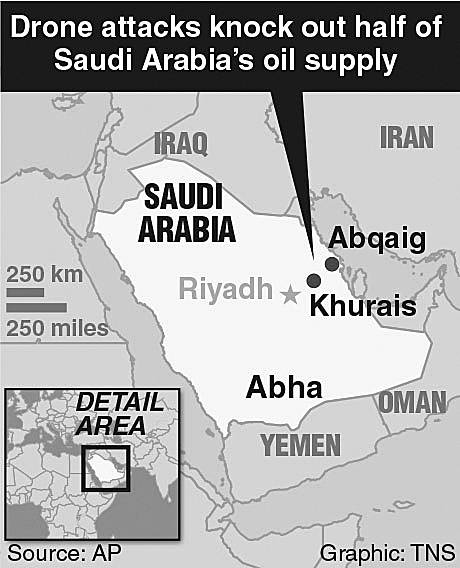BAGHDAD — The fires raging in Saudi Arabia’s Abqaiq oil processing plant could portend a larger, regionwide conflagration between Iran and Saudi Arabia, analysts worry.
What first appeared on Saturday to be a series of contained fires caused by drone attacks for which Yemen’s Iran-backed Houthi movement claimed responsibility, swiftly turned out to be a devastating blow cutting some 5.7 million barrels per day of production at Aramco, Saudi Arabia’s flagship oil company.
And what quickly followed that was a war of words from Washington, in which several Trump administration officials placed the blame on Iran, without supplying evidence. In a Sunday evening Tweet that did not specifically mention Iran, President Donald Trump wrote, “There is reason to believe that we know the culprit, are locked and loaded depending on verification, but are waiting to hear from the (Saudi) Kingdom as to who they believe was the cause of this attack, and under what terms we would proceed!”
Tehran, for its part, on Sunday dismissed White House allegations that it was behind the attack, saying officials including Secretary of State Michael R. Pompeo were engaged in “maximum deceit.”
The fires have halved the kingdom’s oil production, according to Saudi Energy Minister Prince Abdulaziz bin Salman and are sending jitters through oil markets.
On Saturday, Pompeo tweeted, “Iran has now launched an unprecedented attack on the world’s energy supply.”
He also insisted there was “no evidence the attacks came from Yemen.”
Sen. Lindsey Graham, R-S.C., a key White House ally, went further, saying that the Houthis’ attack should push the U.S. to “put on the table an attack on Iranian oil refineries.”
“Iran will not stop their misbehavior until the consequences become more real,” he added, “like attacking their refineries, which will break the regime’s back.” White House counselor Kellyanne Conway, appearing on “Fox News Sunday,” said Iran bore responsibility, echoing Pompeo’s assertion.
Pompeo’s Iranian counterpart, Mohammad Javad Zarif, responded on Twitter that “the U.S. and its clients are stuck in Yemen because of the illusion that weapon superiority will lead to military victory.”
“Blaming Iran won’t end disaster.”
There’s little question that Saturday’s attack represents a major shift from previous Houthi strikes. The group, which has been fighting an all-out war against a Saudi-led coalition in Yemen since 2015 that has left tens of thousands dead and devastated the country, has often dispatched short-range drones and missiles across Yemen’s border with Saudi Arabia.
But the weekend attack, according to a statement from Houthi military spokesman Yahia Sarie, was far larger, and came “after advance monitoring and operation between the honorable and free people inside Saudi Arabia.”
In January, a U.N. panel of experts reported that the Houthis had drones with a range of up to 930 miles. Earlier this year, the Houthis were blamed for a drone strike on the Shaybah oil field near the Saudi-UAE border, more than 800 miles from territory known to be in their hands. (Abqaiq is roughly the same distance.)
There is also some speculation that Iran’s other proxies in the region may have been involved. (Tehran has nurtured links with a coterie of paramilitary groups in Lebanon, Syria, Iraq and Afghanistan, which it has wielded to attack its enemies or aid its allies.)


